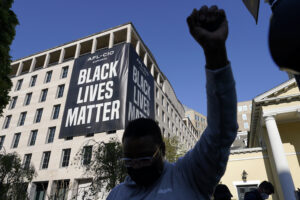Police Use of ‘Stingray’ Phone Surveillance Hurts Minority Communities Most
With authorities using "cell site simulators" to gather ever more cellphone information, privacy and civil rights groups fear that an effort “to chill broad social movements” is underway. A federal investigation, the groups say, is necessary. Flickr
Flickr
Police use of cellphone surveillance devices in the past was cloaked in mystery. Now, it is out in the open.
We know that officers can, with little preparation, set up at remote locations and sweep up all of the cellphone data they want in those areas. Phones meant for private communication have become activity trackers for the government. Though this has become widely known, police departments and other government agencies are still fighting hard to keep the secrecy around these devices intact.
The main surveillance tool is the Stingray, which is a “cell site simulator.” The Stingray is a briefcase-sized device that can electronically pretend to be a cell tower so all phones in the immediate area will attempt to access it, which means it can collect the data from those phones. Critics of Stingray surveillance once thought that the device collected only metadata, but we now know it can collect actual content — in effect, recording phone calls.
Police departments and other agencies that use Stingrays, such as the IRS, sign a nondisclosure agreement when they purchase the devices. As a result, no mention of the device generally occurs in court cases involving information from Stingray investigations.
Like some U.S. agencies, some Canadian police departments are facing scrutiny after refusing to disclose the use of Stingrays.
Given history, it seems likely that the group that’s been hit hardest by Stingray use has been minorities, which is why a number of privacy and civil rights groups delivered a letter to the Department of Justice (DOJ) and the Federal Communications Commission (FCC) on March 16 demanding an investigation into warrantless Stingray use across the country.
“The use of Stingray devices is particularly dangerous to black communities, not only to our safety but also to our civil rights,” Malkia Cyril, founder and executive director of the Center for Media Justice, told Truthdig. The center was one of the organizations that signed the letter requesting an investigation.
Cyril said she believes local police departments are using Stingrays to disrupt black social movements, such as Black Lives Matter. Civil rights organizations and journalists have been able to identify cases in which government agencies conducted surveillance on Black Lives Matter protests. This isn’t hard to believe in the same country that had Cointelpro.
“They [Stingrays] are being used against legal protesters organizing to save their lives, improve the world, and defend the human rights of the most vulnerable members of our society — while bolstering the power of an already brutal police force,” Cyril said.
“We have every reason to assume that the Department of Homeland Security and FBI are using surveillance tactics to chill broad social movements,” Brandi Collins, media justice director for Color of Change, told Truthdig. She pointed out that predictive policing tactics like those used under the “broken windows theory” cause police departments to focus on people they believe are more likely to commit crimes. Historically, that has meant focusing on those in minority communities. Add new surveillance tools and a lack of oversight and you get massive groups of minorities being spied on regularly.
“Certainly, communities that are already under scrutiny will be even further under the microscope, and any evidence that comes from that will simply reaffirm the practice of overpolicing in our communities,” Collins said.
Both Cyril and Collins agreed there is evidence that police departments have violated the law in order to hide the use of Stingrays. “The only reason Stingray devices aren’t considered illegal is because the law has not caught up to the technology yet,” Cyril said.
The organizations asking the FCC and DOJ to investigate Stingray use want the agencies to use their existing powers to increase oversight and create a public registry of the devices. They also want the nondisclosure agreements to end, so agencies cannot hide their use of Stingrays. Collins said the FCC and DOJ Office of Civil Rights should also conduct a civil rights impact study and release the findings.
There is no way to tell how much of an impact that Stingray surveillance by police, the FBI and other agencies has had on minorities and other communities. Until the secrecy around these devices ends, the organizations asking for an investigation fear that the damaging effects of surveillance will multiply. Surveillance affects all Americans, but for people of color—historically targeted by law enforcement—the effect is amplified to a brutal level.
Your support matters…Independent journalism is under threat and overshadowed by heavily funded mainstream media.
You can help level the playing field. Become a member.
Your tax-deductible contribution keeps us digging beneath the headlines to give you thought-provoking, investigative reporting and analysis that unearths what's really happening- without compromise.
Give today to support our courageous, independent journalists.









You need to be a supporter to comment.
There are currently no responses to this article.
Be the first to respond.